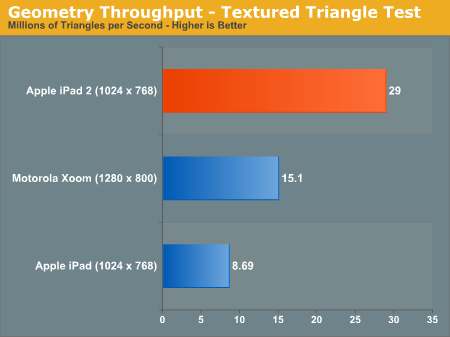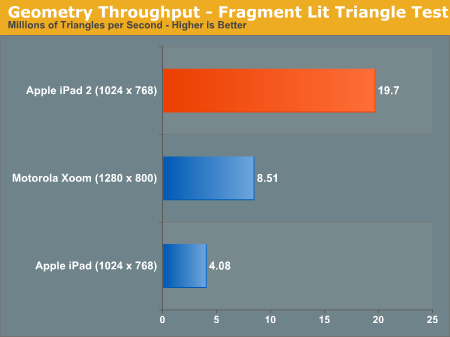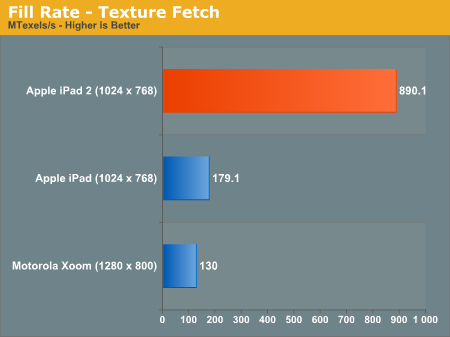Apple iPad 2 GPU Performance Explored: PowerVR SGX543MP2 Benchmarked
by Anand Lal Shimpi on March 12, 2011 3:04 PM EST- Posted in
- Smartphones
- Apple
- iPad
- GLBenchmark
- iPad 2
- Mobile
- Tablets
Earlier this morning we published our first impressions on Apple's iPad 2, including analysis on camera quality and a dive into the architecture behind Apple's A5 SoC. Our SoC investigation mostly focused on CPU performance, which we found to be a healthy 50% faster than the A4 in the original iPad - at least in web browsing. We were able to exceed Apple's claim of up to 2x performance increase in some synthetic tests, but even a 50% increase in javascript and web page loading performance isn't anything to be upset about. We briefly touched on the GPU: Imagination Technologies' PowerVR SGX 543MP2. Here Apple is promising up to a 9x increase in performance, but it's something we wanted to investigate.
Architecturally the 543MP2 has more than twice the compute horsepower of the SGX 535 used in Apple's A4. Each shader pipeline can execute twice the number of instructions per clock as the SGX 535, and then there are four times as many pipes in an SGX 543MP2 as there are in a 535. There are also efficiency improvements as well. Hidden surface removal works at twice the rate in the 543MP2 as it did in the 535. There's also a big boost in texture filtering performance as you'll see below.
As always we turn to GLBenchmark 2.0, a benchmark crafted by a bunch of developers who either have or had experience doing development work for some of the big dev houses in the industry. We'll start with some of the synthetics.
Over the course of PC gaming evolution we noticed a significant increase in geometry complexity. We'll likely see a similar evolution with games in the ultra mobile space, and as a result this next round of ultra mobile GPUs will seriously ramp up geometry performance.
Here we look at two different geometry tests amounting to the (almost) best and worst case triangle throughput measured by GLBenchmark 2.0. First we have the best case scenario - a textured triangle:

The original iPad could manage 8.7 million triangles per second in this test. The iPad 2? 29 million. An increase of over 3x. Developers with existing titles on the iPad could conceivably triple geometry complexity with no impact on performance on the iPad 2.
Now for the more complex case - a fragment lit triangle test:

The performance gap widens. While the PowerVR SGX 535 in the A4 could barely break 4 million triangles per second in this test, the PowerVR SGX 543MP2 in the A5 manages just under 20 million. There's just no competition here.
I mentioned an improvement in texturing performance earlier. The GLBenchmark texture fetch test puts numbers to that statement:

We're talking about nearly a 5x increase in texture fetch performance. This has to be due to more than an increase in the amount of texturing hardware. An improvement in throughput? Increase in memory bandwidth? It's tough to say without knowing more at this point.
| Apple iPad vs. iPad 2 | ||||
| Apple iPad (PowerVR SGX 535) | Apple iPad 2 (PowerVR SGX 543MP2) | |||
| Array test - uniform array access |
3412.4 kVertex/s
|
3864.0 kVertex/s
|
||
| Branching test - balanced |
2002.2 kShaders/s
|
11412.4 kShaders/s
|
||
| Branching test - fragment weighted |
5784.3 kFragments/s
|
22402.6kFragments/s
|
||
| Branching test - vertex weighted |
3905.9 kVertex/s
|
3870.6 kVertex/s
|
||
| Common test - balanced |
1025.3 kShaders/s
|
4092.5 kShaders/s
|
||
| Common test - fragment weighted |
1603.7 kFragments/s
|
3708.2 kFragments/s
|
||
| Common test - vertex weighted |
1516.6 kVertex/s
|
3714.0 kVertex/s
|
||
| Geometric test - balanced |
1276.2 kShaders/s
|
6238.4 kShaders/s
|
||
| Geometric test - fragment weighted |
2000.6 kFragments/s
|
6382.0 kFragments/s
|
||
| Geometric test - vertex weighted |
1921.5 kVertex/s
|
3780.9 kVertex/s
|
||
| Exponential test - balanced |
2013.2 kShaders/s
|
11758.0 kShaders/s
|
||
| Exponential test - fragment weighted |
3632.3 kFragments/s
|
11151.8 kFragments/s
|
||
| Exponential test - vertex weighted |
3118.1 kVertex/s
|
3634.1 kVertex/s
|
||
| Fill test - texture fetch |
179116.2 kTexels/s
|
890077.6 kTexels/s
|
||
| For loop test - balanced |
1295.1 kShaders/s
|
3719.1 kShaders/s
|
||
| For loop test - fragment weighted |
1777.3 kFragments/s
|
6182.8 kFragments/s
|
||
| For loop test - vertex weighted |
1418.3 kVertex/s
|
3813.5 kVertex/s
|
||
| Triangle test - textured |
8691.5 kTriangles/s
|
29019.9 kTriangles/s
|
||
| Triangle test - textured, fragment lit |
4084.9 kTriangles/s
|
19695.8 kTriangles/s
|
||
| Triangle test - textured, vertex lit |
6912.4 kTriangles/s
|
20907.1 kTriangles/s
|
||
| Triangle test - white |
9621.7 kTriangles/s
|
29771.1 kTriangles/s
|
||
| Trigonometric test - balanced |
1292.6 kShaders/s
|
3249.9 kShaders/s
|
||
| Trigonometric test - fragment weighted |
1103.9 kFragments/s
|
3502.5 kFragments/s
|
||
| Trigonometric test - vertex weighted |
1018.8 kVertex/s
|
3091.7 kVertex/s
|
||
| Swapbuffer Speed |
600
|
599
|
||
Enough with the synthetics - how much of an improvement does all of this yield in the actual GLBenchmark 2.0 game tests? Oh it's big.











219 Comments
View All Comments
djgandy - Sunday, March 13, 2011 - link
^^^ What he said.The same applies on Windows when applications create 640x480 windows. The rendering space is smaller due to window borders.
runner50783 - Sunday, March 13, 2011 - link
Stop your trolling! I don't see any favoritism here and never has on any of Anantech's reviews, tell that to Engadget, Gizmodo and the like.I did not expected anything less than this kind of detailed scrutiny on such an important device, plus due to the lack of true technically educated reviewers for Apple hardware Anandtech has become sort of the reference review site for this devices, a title that if I were Anand, will do what ever I can to keep.
eXces - Saturday, March 12, 2011 - link
it turned out to be an incredible device, i think i will give my iPad to my daughter and buy the iPad 2ltcommanderdata - Saturday, March 12, 2011 - link
Thanks for the quick test on graphics performance ahead of your iPad 2 full review.I noticed that in the Egypt and Pro benchmarks, the frame rate with FSAA is actually the same or higher than without FSAA for the iPad 2. Could you comment on why that would be? I would guess that the SGX543MP2 without FSAA it's purely shader ALU limited, while with FSAA there is dedicated AA hardware so shader performance is not impacted and the A5 has lots of extra memory bandwidth or the SGX is very memory bandwidth efficient so that is not a limitation.
And for the Inifinity Blade comparison, would it be possible to post iPhone 4 shots as well? I believe the higher resolution textures, bump mapping, and specular shaders were already in place in the iPhone 4 version. AA did seem enabled in the iPhone 4, but perhaps only 2x since the iPad's AA looks higher/better.
rish95 - Saturday, March 12, 2011 - link
It probably has a lot of memory bandwidth.I'm guessing:
800 MHz LPDDR2?
metafor - Monday, March 14, 2011 - link
Tile-based rendering suffers little to no loss from AA implementations due to their early throwaway nature.stm1185 - Saturday, March 12, 2011 - link
Surpised how faster it is then the Tegra 2. Even if you factor in the resolution disparity, with the Xoom having about 25% more pixels, it still is really impressive.dj_aris - Saturday, March 12, 2011 - link
You know what would be interesting? To see the exact same benchmarks on a PC GPU. How do these tablets perform against some real Nvidia or ATI hardware? Or even some Intel integrated GPU? And to take it even further, are they more capable than a handheld game console (PSP / DS)?ET - Saturday, March 12, 2011 - link
This is way more powerful than the PSP and 3DS (DS is so underpowered anything would beat it). I agree it'd be interesting to put it in perspective with current and past PC cards and with consoles (well, it'd beat the Wii, but I wonder how far it has to go to catch up to the PS3 and Xbox 360).I believe that a year or two from now phones (and certainly tablets) would be able to drive 720p or even 1080p high quality games. Hook one to a TV, link a controller via bluetooth and you'd have a real console that would compete with current ones (with enough leftover CPU power to let you answer calls via a bluetooth headset while you're playing).
rquick - Sunday, March 13, 2011 - link
You say that the handheld should compete with the consoles in a year or two, but the consoles are also going to take a generation leap in the near future. We might see the next generation xbox and ps sometime next year - my fingers are crossed. From looking at the numbers, I would have to guess that the current xbox is already 6-8 times more powerful than the ipad2. Just a guess, but I would also bet that is overly conservative. The next leap in console graphics should be enormous by comparison since their expected life cycle could be 5 years or more. Once that happens, I don't think the ability to compete with the current (old) consoles would be very a big selling point for a device that costs more than the new console. Again. just a guess on prices, but I think Sony proved that consoles won't sell at $600.